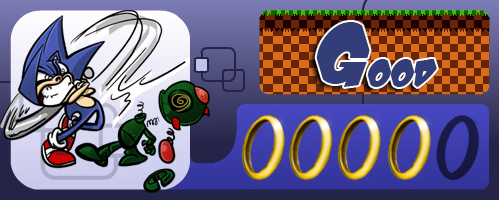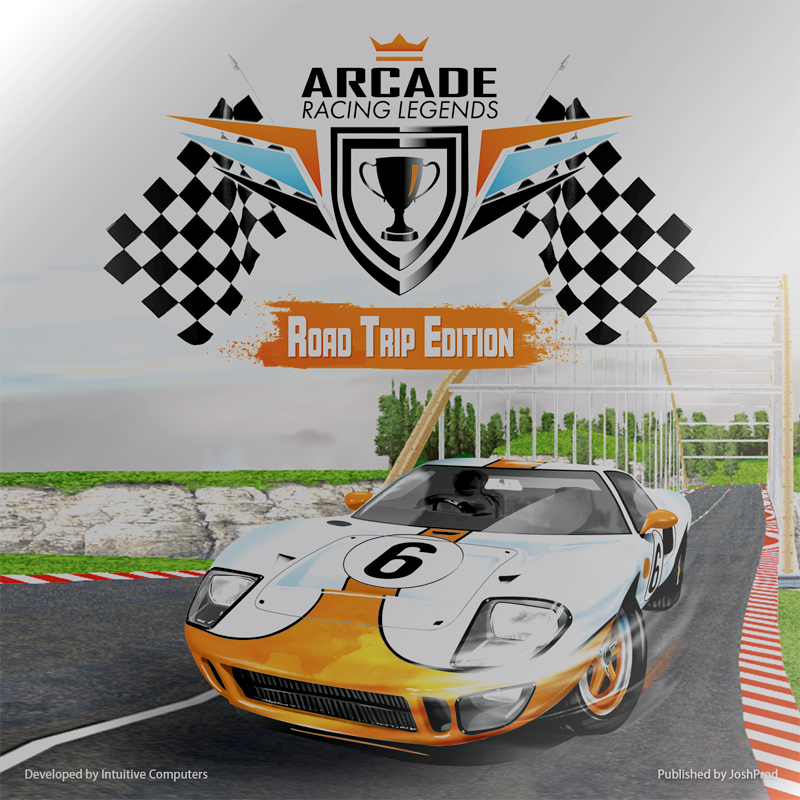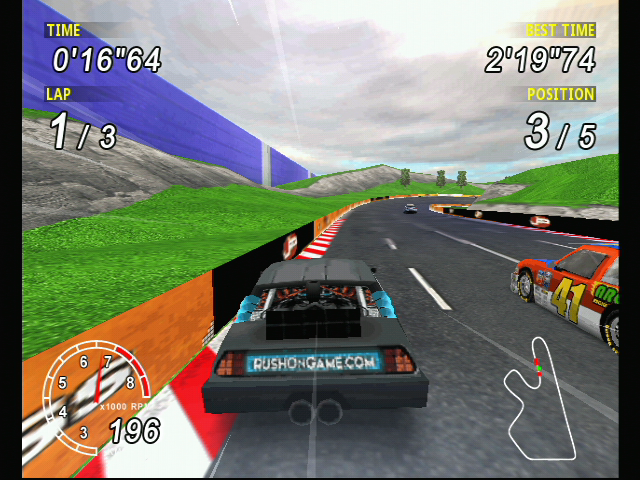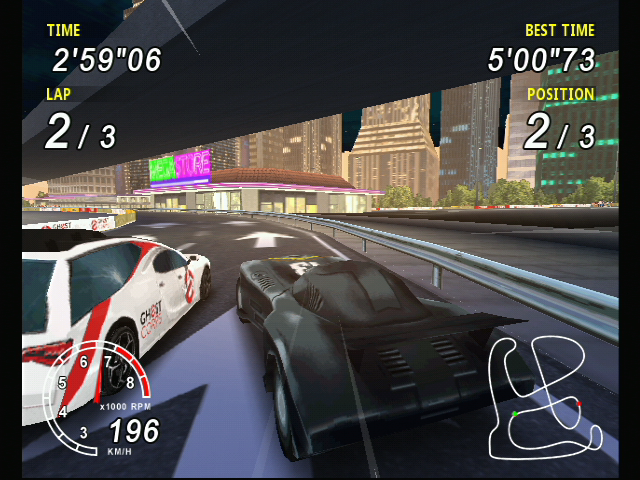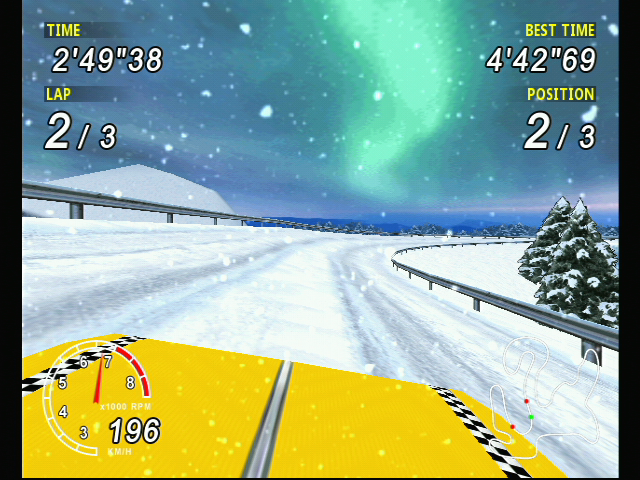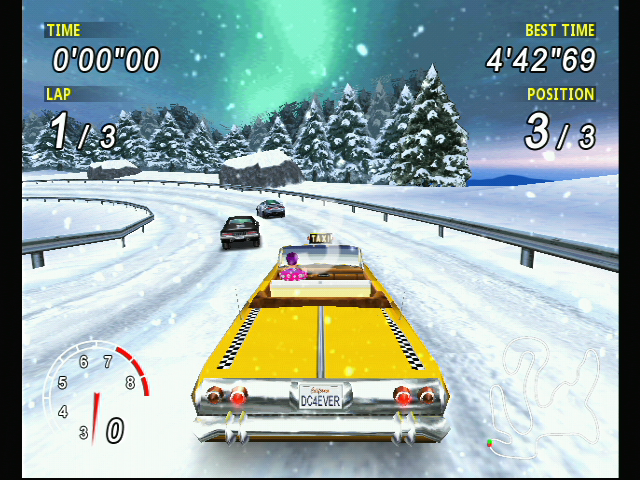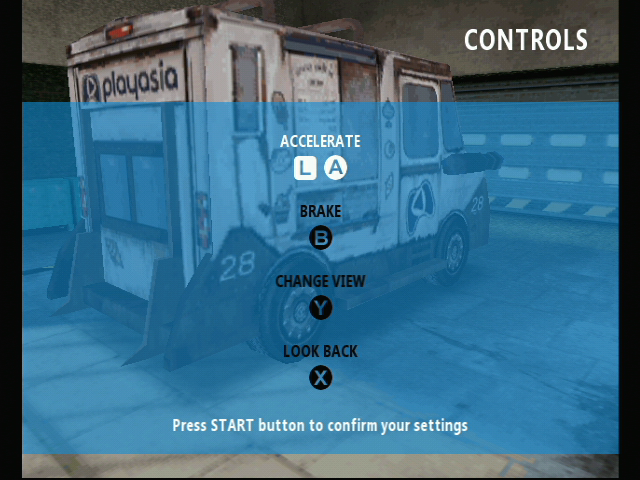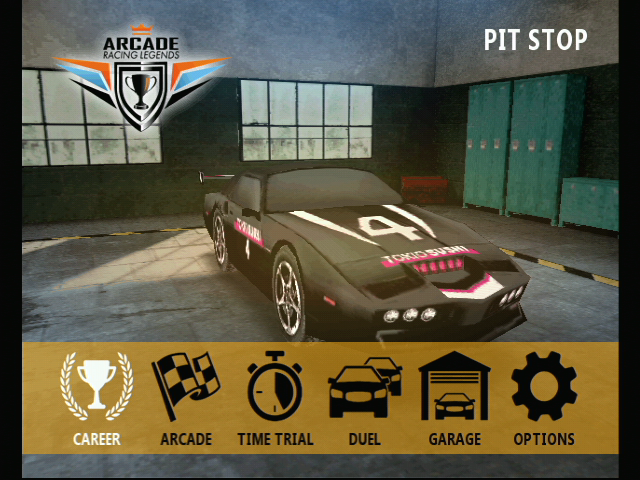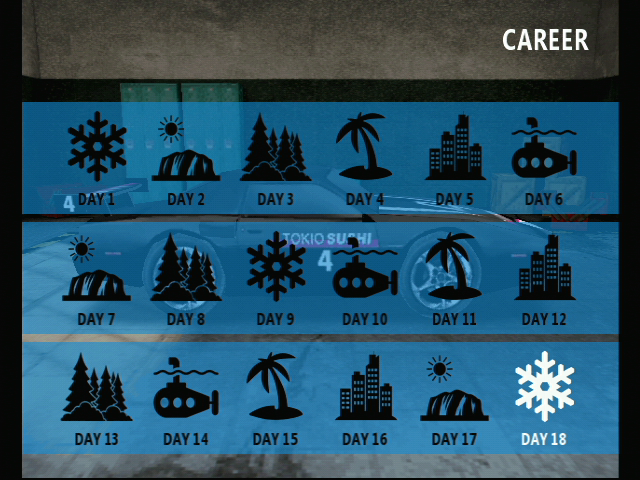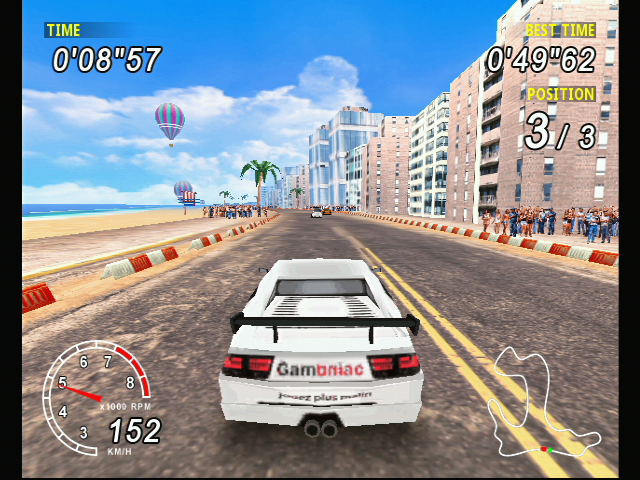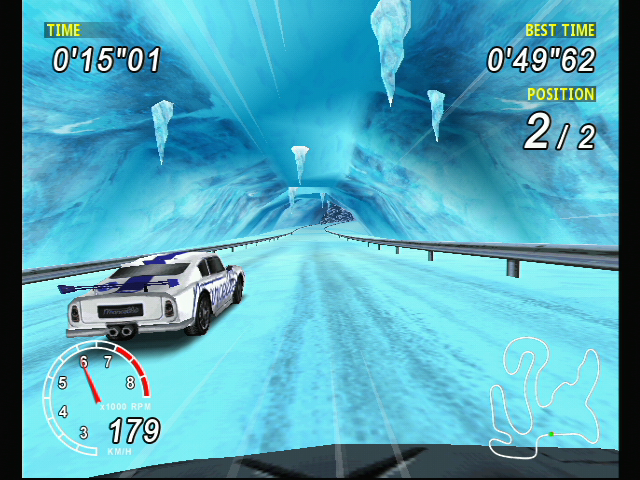With the SEGA Dreamcast indie scene positively booming in recent years, some fans have been craving for a true 3D racing game to finally hit the streets. Thankfully, the folks over at JoshProd and Pixelheart have answered the call with Arcade Racing Legends – a Kickstarter-funded project that began development in June 2019.
Roll on to November 2020, and the backers (myself included) started receiving copies of the game.
The Dreamcast has a great selection of officially released racers, but it also has its fair shake of quite terrible ones too. So where does Arcade Racing Legends (ARL) sit? Find out… right now!
Starting line
At its heart ARL is, as the name suggests, an arcade racing game taking inspiration from classic racers, and featuring several game modes: Career, Arcade, Time Trial and Duel. The latter three are fairly self-explanatory:
- Arcade: Race against up to four computer opponents, unlocking new courses by placing first. There’s a total of seven tracks to unlock, but the final is unlocked through completing Career mode.
- Time Trial: No opponents, just you and a timer. A fun challenge for yourself and friends to see who can do the best.
- Duel: No computer opponents. It’s a straight-up, one-on-one race to the finish line.
A tire-smoking career path
Despite being a stretch goal in the Kickstarter, Career Mode is arguably the game’s more unique and stand-out features. Think of it as a stripped-down version of Metropolis Street Racer. You don’t just race against opponents; you progress through your career by undergoing challenges and learning better driving techniques.
ARL isn’t as complex as MSR, but the essence is there. You have 18 races, or “days,” to complete. The first few days challenge you to drive around a track without hitting the walls. A simple task you might think. However, I totally over-estimated my driving skills and ended up hitting the wall again, and again, and again and … well you get the idea.
It really put me in my place, as I realised that I need to tackle this game in a different way. Just like MSR, ARL’s career mode is teaching you the importance of careful, accurate driving.
What was I training for?
Sadly, this is where one of ARL’s first problems arises. In the first few races, I was using my new precision drifting skills to carefully navigate corners. And it was working. Great success!
But when you get to more complex tracks, with more AI opponents, the game changed. By Day 6, the Beach track, I noticed that the AI cars weren’t drifting, or even braking, around corners. They just drove at a constant speed, the entire race. Cheating blighters!
Early on the Beach track, you hit a sharp s-bend, followed by a couple more corners. And while my car was lumbering around each corner like a horse trying to turn on ice, the AI was like a lithe mountain goat, bounding past a troubled rock climber without a care in the world.

And this was a big deal. These early corners gave the AI a huge lead, and I ended up spending the rest of the race playing catch-up. At this point, I gave up on drifting entirely because it slowed me down too much. Even bumping off the walls was a faster option.
But ARL offers basic car tuning options – adjusting the steering, braking and grip of all the cars. I ramped all these up to the max, so my cars no longer had a tendency towards drifting. It wasn’t a perfect solution, but it meant I was racing more like the AI.
After finally beating the Beach track, I thought the game was only going to get harder. But the next few races were super easy. I breezed through them – mostly because the other tracks didn’t have such annoying corners at the start, and I could easily stay ahead of the AI.
Racing legends indeed

All 24 cars are open to you from the beginning. As part of the Kickstarter, companies could pay to have their branding on the in-game vehicles. It was a really cool idea and makes them more unique than other racers.
Though they aren’t officially licensed, they are clearly modelled after popular vehicles from real life, video games and even movies. For example, you can drive a Bugatti Veyron, a Porsche, the Hornet from Daytona, a cab from Crazy Taxi, or even the Batmobile from Batman/Batman Returns. And they look awesome.
But curiously, there’s no real difference in performance. They seem to accelerate and handle the same, and they all have the same top speed of 196 kph. Size plays a small factor – I could take the small Lancia Delta from SEGA Rally round corners more easily than the long wheelbase of Ecto-1 from Ghostbusters. But the difference was only slight.
I guess this means that everyone has an equal chance and those backers who paid to have their logos plastered on the cars wouldn’t be jealous if one company were featured on a faster vehicle. But it seems weird that an ice cream van would drive as fast as a Ford GT on a straight and handle the same way.
Imperfect perfections
Pixelheart has accomplished some truly impressive feats with ARL. However, some of these achievements are marred by the glitches that accompany them.
The physics in the game are outstanding. As you race, your car tilts on its suspension as it shifts around the corners. And as you go flat out, you get this incredible sensation of speed that you rarely get from other racers.
However, those mechanics have led to graphical glitches, particularly driving in the first-person view. When it works, the first-person view is awesome. You see the bonnet shift and move as you speed up, or slow down. It dips and weaves as you drive up and down inclines and around corners.

But all too often, the bonnet of the car will completely disappear. In fact, on certain tracks, the bonnet is completely gone for the entire race! And when you go up and down sharp dips, the visuals will glitch so you can see the tires underneath. A couple of cars don’t even seem to have had their bonnets placed correctly at all – there’s just a huge gap at the bottom of the screen, so the bonnet is just floating in front of you and the tires below are totally exposed!
And while the game holds a pretty steady framerate throughout, oftentimes the AI cars will visibly jerk back and forth as you approach and pass them. This somewhat ruins the otherwise smooth, fast-paced feeling the game delivers.
The rust shines through
ARL has some other niggling imperfections that don’t affect the gameplay in any way, but it would be a disservice if I didn’t mention them.
Firstly, there’s no analog accelerating or braking in the game. The default controls are A to accelerate and B or X to brake. You can change your controls in the options, but even switching to L and R triggers (like most racers), there’s no analog. With just the slightest squeeze of the trigger, it’s all or nothing.
It’s a shame because you lose the finesse of driving that so many other racers deliver. It feels like a game with an emphasis on drifting would have benefitted from having this feature.
While the music in the game is genuinely excellent and lends itself perfectly to the frantic, arcade-style gameplay, the sound effects are a whole other kettle of rotting fish and something that’s left to be desired.
Collision sounds effects alternate between someone crashing two metal trashcan lids together and a cartoon-style ‘bump’ effect. And all engines sound exactly the same, a humming drone that varies slightly depending on your speed. All these noises tend to distract from the music and can be irksome after a few races.
And this leads me to mention another glitch. The game offers you the option to lower the sound effects. But when I did that, aiming to remove the annoying sounds, instead it turned down the volume of the announcer at the start of the race – NOT the sound effects! The engine hum and the ‘bumps’ and ‘boings’ of collisions were just as loud and annoying as before. Very frustrating.
And, if like me, you enjoy a good vibration from your rumble pak, get ready to be disappointed. ARL has possibly the worst rumble I’ve ever experienced in any game. It’s so puny you barely feel it. And I think it could be a glitch. There’s an option to adjust the vibration, but it does nothing. I even tested out three different rumble paks on three different controllers in case mine was broken. But they weren’t broken, the game was.

Overall, the game’s visuals are a mixed bag. The cars look good, though some lack the refinement and detail that others offer. The tracks are well designed, but the backgrounds range from lovingly created, to considerably basic and unappealing.
There were times I genuinely said out loud, “Oh wow. That looks gorgeous!” And then other times, the backdrops looked bland and soulless. Some lighting effects, especially in the night city track, looked washed out and … just bad.
While most of these problems don’t harm the gameplay they do give the sense of an unfinished game. Especially when you add in the problems with the graphical glitches, audio and vibration.
However, I feel as it’s an indie title, it’s easier to let some of these issues slide. Sure, it’s a shame because the game comes so close to sitting among the Dreamcast’s best, but it’s let down on the final lap by missing out on some sorely needed polish.
I say these things in a hope that should Pixelheart (or another indie studio) attempt another 3D racer, that they improve these missteps. Because if they do that, they could easily create a racing game that stands amongst the console’s best.
Solid gameplay and design win the race
Despite my complaints, ARL is an impressive game. Firstly, the gameplay is excellent. It’s smooth and you get a great sensation of speed – just what I like from a racer.
Racing along at blistering speeds is only made more enjoyable by the solid track designs. Each course tends to follow the staple arcade racing tropes, such as a desert, forest, and city track (at night, of course). They each have some cool set pieces and are interesting to race along.
You also get some more imaginative tracks, such as racing in an underwater tunnel, while whales and submarines float above you. Or a wonderfully snowy track, with banking corners and nose-diving dips and a lovely backdrop that genuinely reminded me of Lapland.
And despite the cheating AI, it is possible to beat it. Which makes it feel all the more rewarding. After beating the Career mode, you unlock the bonus Inca track, which is another stand-out circuit to race on. Well worth the effort.
I would also be remiss not to mention the top soundtrack. The music is excellent. It’s not something I’d necessarily listen to in the car or while chilling at home. But the base-pumping trance, electro, and rock style tunes fit perfectly to this frenetic arcade racer.
Final thoughts
Arcade Racing Legends is a quality game, with mostly solid visuals, great physics, excellent music, and sublime gameplay. But it suffers from glitches, cheating AI, and other annoyances that hold it back from being one of the Dreamcast’s genuinely great racing games.
It feels like this is one 2020 release (along with Cyberpunk 2077) that would have benefitted from a few extra months of baking in the proverbial development oven. Because even though this is an indie title, gamers are being charged for a full-price Dreamcast game.
That said, Arcade Racing Legends achieves some great things, and shows promise of what we could expect in the future of Dreamcast releases.
It’s amazing to think that a small indie development team, with the financial support of the community, was able to deliver this game. It’s far better than some official releases on the system and that’s really saying something. Despite its flaws, Arcade Racing Legends is a must-have for any Dreamcast fans.











